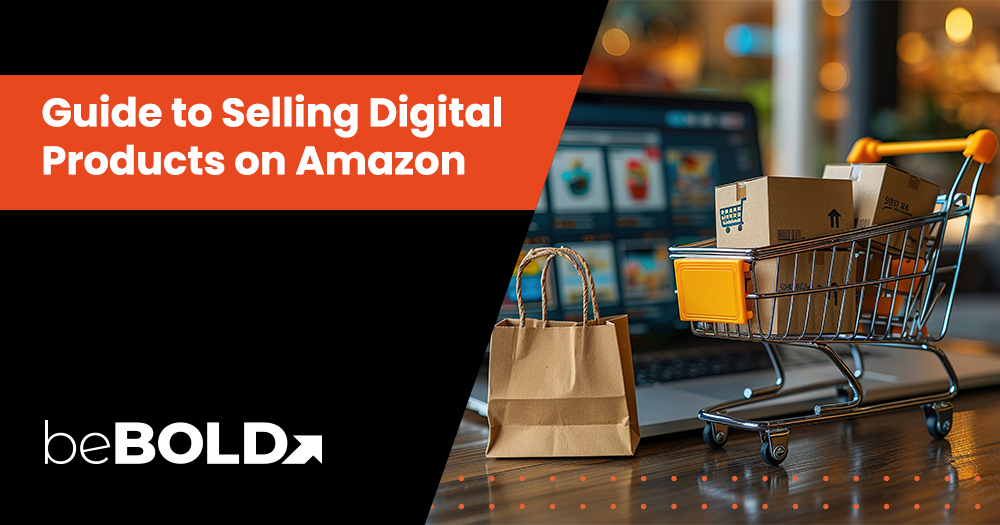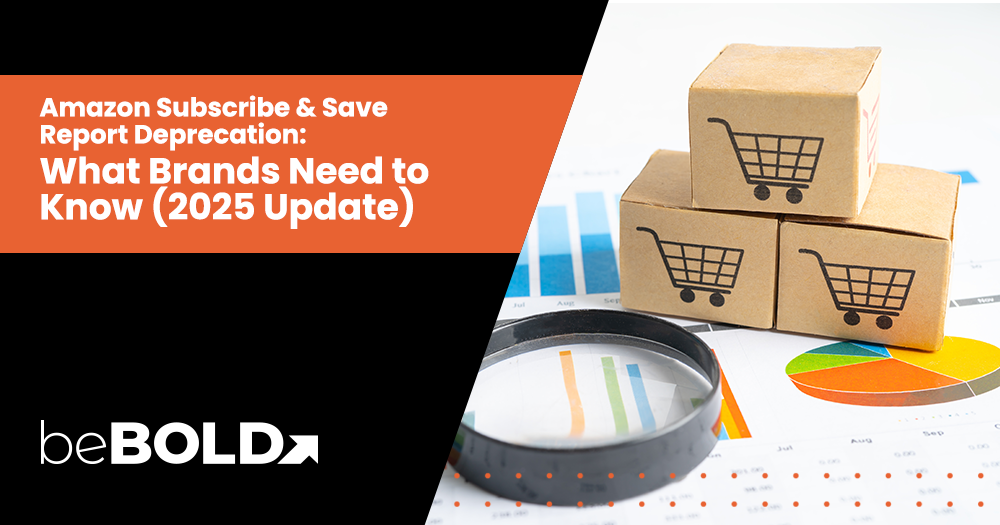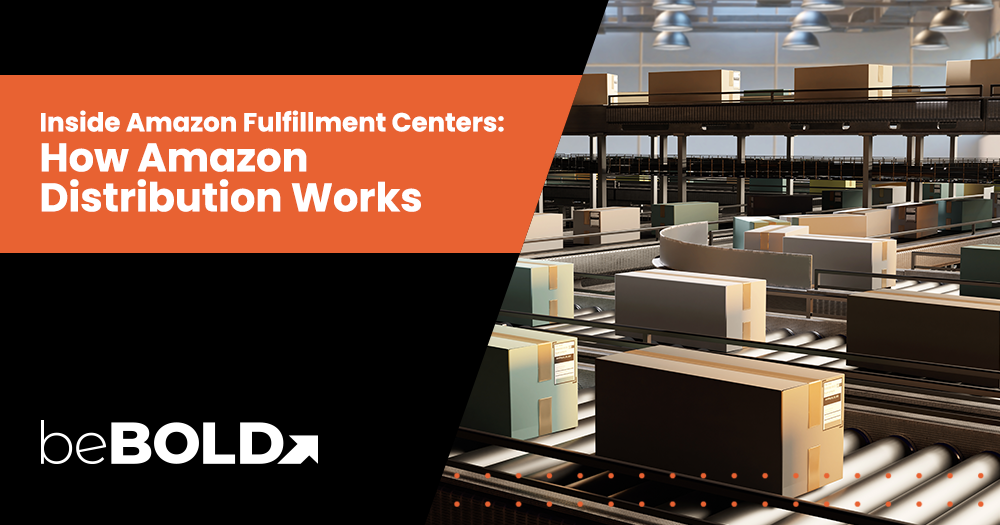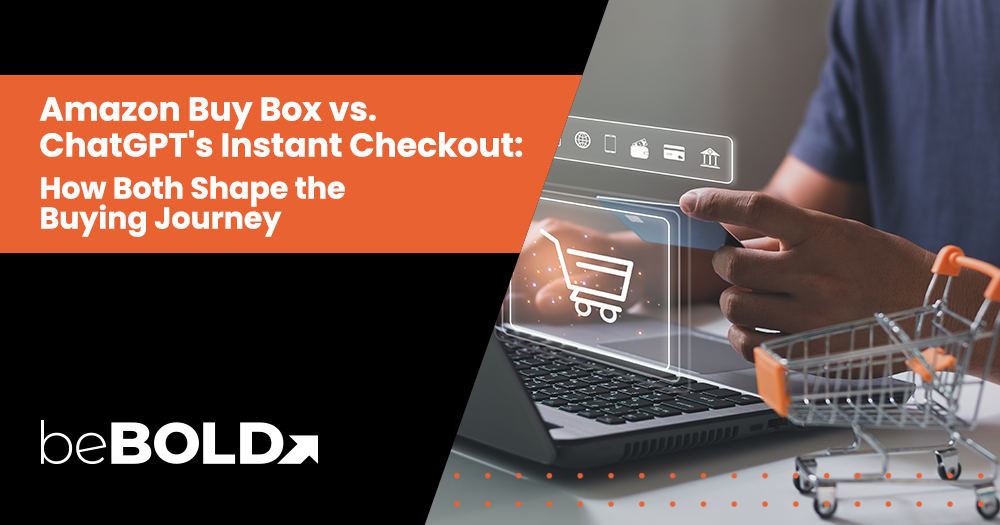Key Highlights
- Selling digital products on Amazon offers high margins, zero inventory, and instant global reach.
- Amazon offers tailored platforms for every creator—KDP, Merch by Amazon, TuneCore, Appstore, and Prime Video Direct.
- No shipping, no storage, no stress—sell globally with digital products that deliver instantly.
- Keep 90%+ profit margins—once created, your digital product can sell endlessly with almost no extra cost.
- Success depends on finding a product-market fit through niche research, quality creation, and clear value delivery.
- Adhering to platform-specific best practices (ACX, KDP, Merch, etc.) ensures compliance and approval.
- Drive 24/7 global sales with Amazon’s built-in traffic and on-demand delivery model.
- Avoid common pitfalls like copyright issues, pricing mistakes, and low-quality listings with our proven tips.
- Use Amazon ads, social media, and email to boost discoverability and create repeat customers.
- beBOLD helps you go beyond listings—with strategy, advertising, and listing support that turns visibility into sales.
Selling digital products isn’t just trending—it’s one of the most innovative ways to build a scalable income stream without the stress of inventory, packaging, or shipping. And if you're wondering where to begin, Amazon is hands-down one of the best platforms to launch on.
Why? Because it already has the audience, the trust, and the tools. From Kindle Direct Publishing for authors to Merch by Amazon for designers and even the Amazon Appstore for developers, there are tailored pathways for different types of digital creators. Whether you're a writer, artist, musician, or entrepreneur, there’s room for your product to thrive.
In this blog, we’ll walk you through how to create, list, and sell digital products on Amazon—from finding the right niche to optimizing your product for visibility and conversions. If you’re ready to turn your skills into a source of income, this guide’s for you. Let's dive in!
What Are Digital Products? Types Explored & Why Is It Popular?

Digital products are online-only items without shipping, storage, or inventory. Think of them as downloadable or streamable files like eBooks, music, software, or digital art. To put it simply, if it lives on a screen and delivers value without a physical form, it’s a digital product.
Types of Digital Products
- eBooks: Dive into new worlds or sharpen your skills—no bookshelf required.
- Software and Applications: Smart tools that help you work faster, play better, and do more.
- Digital Art: Where creativity meets pixels—perfect for collectors, creators, and everyone in between.
- Music & Audio: Set the mood, tell your story, or soundtrack your next project with a click.
- Online Course: Knowledge on demand—from side hustles to career upgrades, it’s all here.
Popularity and Demand on Amazon
Amazon makes selling digital products scalable and straightforward. As of 2024, the platform already serves over 315 million active customers worldwide, which is definitely a bigger number.
Whether you're a writer, designer, musician, or educator, platforms like KDP, Merch by Amazon, and TuneCore make it easy to get your content in front of buyers. And for writers especially, learning How to Self Publish on Amazon can help you optimize your book and fully leverage the tools Amazon provides for creators. With global interest in digital goods booming, Amazon gives you the opportunity to turn your creativity into consistent revenue.
Comparison of Amazon with Other Digital Product Platforms
Amazon's extensive user base and robust e-commerce infrastructure make it a more lucrative platform for selling digital products than other platforms like Walmart, Etsy and eBay in the US eCommerce market. Here's how Amazon stands differently from these platforms:
|
Amazon |
Other Digital Platforms |
|
Huge customer base |
Limited reach |
|
A variety of digital product categories |
May have a narrow focus |
|
Broad global exposure |
Limited geographical reach |
|
Offers print-on-demand through KDP |
Few platforms offer print-on-demand |
Most platforms can’t compete with Amazon’s reach. While sites like eBay and Etsy serve niche audiences, Amazon brings global exposure across categories—be it eBooks, music, or online courses.
With tools like KDP, Merch by Amazon, and TuneCore, listing and promoting digital products is simple. Plus, features like print-on-demand let you offer both digital and physical versions—something most platforms can’t.
In short, Amazon gives you scale, flexibility, and a ready-to-buy audience—all in one place.
What Types of Digital Products Can You Sell on Amazon?

Amazon provides various platforms to sell digital products, reaching millions of customers worldwide, including your target audience. Let's have a look at these various types.
1. eBooks and Guides

With Kindle Direct Publishing (KDP), authors can quickly publish and share eBooks with a global audience. Whether you’re into fiction, how-to guides, or educational content, Amazon KDP allows you to publish your eBook without the high upfront costs. Plus, with print-on-demand options, you can cater to readers who prefer physical copies while still selling digitally.
beBOLD Tip: Publishing through KDP is easier when you understand the full process—How to Sell Books on Amazon breaks down how to launch, price, and scale both eBooks and print-on-demand titles effectively.
2. Software and Applications

The Amazon Appstore is an excellent platform for selling apps, games, and software directly to Amazon’s vast customer base. Whether it’s a productivity tool or a mobile game, the App Store provides developers with robust promotional tools to ensure visibility and help boost sales. Plus, apps are easy to update, allowing you to keep users engaged with fresh features and improvements.
3. Digital Art and Photography

Artists and designers can easily monetize their digital artwork through Merch by Amazon. By uploading their designs, Amazon will print and ship merchandise like t-shirts, mugs, and hoodies whenever someone makes a purchase. This allows creators to focus on their art while Amazon manages production and delivery.
4. Music and Audio

For musicians, TuneCore, a service available through Amazon Music, offers an easy way to distribute music globally. Whether you’re an independent artist or part of a band, TuneCore lets you reach Amazon’s vast music marketplace. You can easily focus on your creativity while Amazon handles licensing, royalties, and distribution.
5. Video

Prime Video Direct lets creators upload and sell video content, ranging from movies and TV shows to educational tutorials and web series. With the ability to reach both Amazon Prime members and non-members, this platform offers excellent monetization opportunities. Whether you’re a filmmaker, educator, or content creator, Prime Video Direct is a solid option to distribute and make money from your videos.
Benefits of Selling Digital Products

Selling digital content products on Amazon isn’t just a smart move—it’s a great way to be a game-changer for creators, freelancers, and online entrepreneurs. Here are the three most important benefits of selling digital products:
1. High-Profit Margins
With no production or shipping costs, digital products deliver margins up to 90%. Each sale after the first is nearly pure profit.
2. Minimal Storage and Fulfillment Hassles
No warehouses, no packaging—your digital product stays online and delivers instantly, saving time, money, and stress.
3. Global Reach and 24/7 Sales
Sell worldwide around the clock—your product is always live, accessible, and ready to generate revenue.
4. Trust and Credibility of Amazon
Leverage Amazon’s trusted reputation to boost buyer confidence in your digital products. Shoppers are more likely to purchase from a platform they already trust.
5. Instant Gratification
Customers receive digital products immediately after purchase, increasing satisfaction and reducing cart abandonment. This fast delivery model fits modern buyer expectations.
6. Automated Delivery
No need to manually fulfill orders—Amazon handles the delivery process automatically. This saves time and ensures a seamless customer experience.
7. Scalable
Amazon’s global reach and robust infrastructure let you scale your digital product sales effortlessly. Whether selling one product or thousands, growth is built-in.
Step-by-Step Guide to Selling Digital Products on Amazon

Have your digital product ready and wondering what’s next? Let’s break down the process of getting it live on Amazon step by step without being overwhelmed.
1. Market Research and Product Selection

Before jumping in, take a moment to really understand what’s selling—and, more importantly, why it's selling. Amazon’s digital marketplace is vast, so do a little digging instead of guessing.
- Browse Best Sellers in eBooks, music, apps, or art categories.
- Use tools like Google Trends, Amazon Best Sellers, or third-party apps to spot what’s trending. This will help you in doing your keyword research.
- Look at top-rated listings—check how they’re titled, what language they use, and how they describe value.
This clarifies the audience's wants and helps you shape your product to meet that demand. The sweet spot? A digital product you’re excited to create that also fills a real market need.
2. Creating Your Digital Products
Now that you’ve locked in your niche, it’s time to bring your idea to life.
What you create depends on your category:
- Writing an eBook? Focus on value, formatting, and a scroll-stopping cover.
- Building an app? Keep the UX clean and solve a real problem.
- Creating music or art? Make it high quality, polished, and ready to share.
Pro tip: Quality matters more than speed. This is your storefront, your brand, so take the time to edit, fine-tune, and perfect it before proceeding.
3. Setting Up Your Seller Account

Once your product is ready to sell, you'll need a seller account. Go to Amazon Seller Central and hit Start Selling.
You can choose:
- Individual Seller – No monthly fee, but you pay per sale.
- Professional Seller – Monthly fee of $39.99, ideal if you're planning for volume.
During setup, you’ll be asked for:
- Business details (name, address, contact info)
- Credit card and bank details
- Tax information
Once you're in, read Amazon’s digital product policies. Staying compliant now saves you from headaches later.
4. Effective Product Listings and SEO
Your listing is your pitch. And with thousands of competing products, how you present yours makes all the difference.
Here’s what a standout listing includes:
- A keyword-rich title that’s clear and searchable
- A punchy description that tells buyers what they’ll get—and why it matters
- Bullet points with key features and benefits
- High-quality visuals (covers, screenshots, mockups, etc.)
- Relevant keywords in backend search terms
If you’ve got early testimonials or reviews—add them. They build instant trust.
And don’t forget: good SEO strategy isn’t just about cramming in keywords. It’s about making your product discoverable, clickable, and compelling.
Best Practices for Selling Digital Products

While selling digital products on Amazon may seem straightforward, achieving success in your digital store requires meticulous planning and adherence to best practices, including creating an Amazon seller account. Here's what you need to keep in mind while selling various digital products on Amazon:
1. Audible

Planning to sell audiobooks? You must meet ACX (Audiobook Creation Exchange) standards to ensure your work is accepted on Audible and other channels.
Dos:
- Make sure your audio has a consistent tone and volume across all chapters.
- Start and end with clear opening/closing credits.
- Submit either all mono or all stereo files—not a mix.
- Include a short retail sample (1–5 minutes long) without explicit content.
Don’ts:
- Don’t mix stereo and mono audio in one project.
- Avoid any sample that contains sensitive or explicit language.
- Never exceed the 120-minute limit per file.
- Don’t skip credits—they’re mandatory.
2. Amazon Merch on Demand
Selling custom tees, hoodies, and more? Merch on Demand lets you upload artwork and get paid when it sells—no inventory required. But there are strict content rules.
Dos:
- Only upload original designs that don’t violate copyright or trademarks.
- Match the spelling of your artwork with the text of your product listing.
- Use RGB color mode, 300 DPI, and ensure your file is under 25MB.
- Keep designs clean and age-appropriate for youth sizes if applicable.
Don’ts:
- Don’t use copyrighted logos, slurs, or anything offensive.
- Avoid blurry, watermarked, or low-res images.
- Never include contact info or external links in your metadata.
- Don't mislead users with unrelated tags or SEO stuffing.
3. Kindle Direct Publishing (KDP)
Publishing an eBook or paperback? Amazon’s KDP platform is ideal, but it requires accuracy and professionalism.
Dos:
- Proofread everything—correct typos, layout issues, and repetition.
- Use metadata smartly to boost discoverability (titles, keywords, etc.).
- Design a clean, appealing book cover that fits Amazon's image specs.
- Upload files in formats like DOCX or HTML for best results.
Don’ts:
- Don’t misrepresent your book’s content in the title or description.
- Avoid adding links, other book mentions, or promotional blurbs in metadata.
- Don’t create covers that are pixelated or contain sales claims.
- Skip puzzle books and journals unless you're using print-on-demand.
4. TuneCore (for Music)
Distributing music on Amazon through TuneCore? Your artworkcover art and track info must meet platform standards or risk rejection.
Dos:
- Upload high-res album art (at least 1600x1600px, JPG/PNG/GIF).
- Keep the design clean—just your name and track title if needed.
- Stick to RGB color mode and 72–300 dpi resolution.
- Ensure you own the rights to every image and track.
Don’ts:
- Don’t add pricing, emails, or “CD”/“Digital” labels.
- Avoid stretched or cut-off visuals.
- Never use brand logos or mention music platforms like iTunes.
- Don’t squeeze all artwork into a corner or leave space.
5. Amazon Developer (Apps)
Want to list an app on the Amazon Appstore? Make sure it’s polished and policy-friendly before submitting.
Dos:
- Ensure your app is family-safe, especially if children might access it.
- Comply with all legal requirements in your region.
- Test your app thoroughly—functionality and design matter.
Don’ts:
- No offensive content or inappropriate language.
- Don’t infringe on others' intellectual property.
- Avoid skipping privacy policies and age ratings if relevant.
6. Prime Video Direct
If you upload movies or shows to Prime Video, you must follow content guidelines and provide professional-level material.
Dos:
- Submit original, copyright-cleared content.
- Upload films or series—not random clips, vlogs, or compilations.
- Make sure your title has structure: clear visuals, proper metadata, and high resolution.
Don’ts:
- Don’t reuse public domain content or duplicate existing shows.
- Avoid user-generated content, tutorials, product demos, or unboxing.
- Never try to upload YouTube-style content—it won’t pass.
Marketing Strategies for Digital Products

ALT TEXT: Marketing Strategies for Digital Products Infographic
A multifaceted marketing approach is essential to selling digital products effectively. Leveraging various strategies, such as Amazon advertising, social media marketing, and email marketing, can significantly increase your product’s visibility and drive sales.
1. Utilizing Amazon Advertising
Amazon provides various advertising solutions to promote your digital products. Sponsored Products lets you create pay-per-click ads in search results and product pages. You can also use Display Advertising to reach audiences on Amazon sites and third-party websites.
The Demand Side Platform (DSP) enables programmatic buying of display, video, and audio ads both on and off Amazon. Additionally, running deals and promotions can enhance visibility and sales. Regularly track your campaign's performance and adjust strategies as needed.
2. Enhancing Visibility with Social Media
Social media platforms like Facebook, Instagram, and Twitter can help boost your digital product’s visibility. Create engaging content highlighting your product, and interact with your followers through polls, quizzes, or live videos.
Paid ad campaigns and influencer partnerships can further expand your reach. Be sure to tailor your content and approach according to the unique dynamics of each platform for the best results.
3. Email Marketing and Lead Generation
Email marketing remains a powerful tool for promoting digital products. Start by building an email list and offering a free product or discount in exchange for subscriptions: design mobile-friendly, visually appealing emails with compelling subject lines and clear calls to action.
Consistent communication helps build lasting customer relationships and boosts sales.
What to Notice When Selling Digital Products on Amazon?
Selling digital products on Amazon comes with exciting opportunities and a few critical rules. Here's what you need to know to stay compliant and competitive.
1. Eligible Digital Product Categories
You can sell a wide variety of digital products, but they must fit Amazon’s allowed categories:
- eBooks: Instant access to stories, knowledge, and ideas—anytime, anywhere.
Romance, thrillers, sci-fi, fantasy, and historical fiction top the fiction charts.
Top Most Popular Non-Fiction Genres
Biographies, self-help, business, health, and history lead in non-fiction picks.
- Music: Original tracks, albums, and beats—ideal for independent artists.
- Art: From printable wall art to graphic design assets.
- Apps, Software & Games: Available via the Amazon Appstore or for desktop.
- Audible Content: Audiobooks or spoken-word media published through ACX.
Always check category-specific guidelines to avoid rejections.
2. Restrictions and Prohibited Content
- Offensive Material: No explicit or inappropriate content.
- Misleading Descriptions: Avoid inaccurate or deceptive product details as you optimize your Amazon listing.
- Policy Violations: Content promoting hate speech, violence, or illegal activities is prohibited.
3. Intellectual Property Rights Considerations
- Copyright Issues: Ensure you have rights or authorization for any third-party content.
- No Republishing: Don’t publish freely available copyrighted material without permission.
- Avoid Trademarks: Don’t use trademarked names or logos without permission.
Common Pitfalls in Selling Digital Products and How to Avoid Them

In the journey of mastering how to sell items on Amazon, you will face several hurdles. From copyright complications to tricky pricing and customer issues, knowing what to expect (and how to tackle it) makes all the difference.
1. Intellectual Property Issues
Selling digital products without proper rights can lead to takedowns, account suspensions, or legal trouble. Always ensure you own or have licensed all content used. Monitor for piracy and protect your creations with DRM or watermarks.
2. Pricing Challenges
Is the price too high? You lose buyers. Too low? You undercut yourself. Do your research, check competitors' charges, and test price points until you hit that sweet spot. Let the market guide you—not just your gut.
3. Customer Service Management
Digital or not, buyers expect real support. Handle download issues, answer questions quickly, and make the refund process smooth. Use automation tools to manage common queries, but always keep it human when it counts.
Excellent service = great reviews and loyal buyers.
Take Your Digital Products Further with beBOLD
Selling digital products on Amazon—like eBooks, software, music, or templates—requires more than just uploading a file. With beBOLD, you get a partner that knows the ins and outs of Amazon’s digital marketplace.
From optimizing your product listings with the right keywords and visuals to setting up high-converting ad campaigns, beBOLD helps you get discovered and drive consistent sales. Our team focuses on strategy, performance, and growth—so your digital product doesn’t just sit on a shelf; it sells.
Start scaling your online business the smart way. Check out our Amazon seller & vendor full account management services now!
Conclusion
Selling digital products on Amazon offers more than passive income—it’s a gateway to reaching new customers and a global audience while scaling your brand digitally. Whether you're a solo creator or a growing business, success hinges on innovative strategies: finding the right niche, crafting valuable products, optimizing listings, and marketing them effectively.
As digital consumption rises, the demand for eBooks, software, music, and digital downloads online tools continues to surge. With the right approach, Amazon can become a high-impact platform for growing your digital presence and boosting long-term profitability.
Frequently Asked Questions
How Do I Price My Digital Products on Amazon?
Pricing your digital products on Amazon can be tricky. It's essential to strike a balance between competitive pricing and profitability. Research the prices of similar products on Amazon, consider the costs involved in creating and marketing your product, and experiment with different price points to determine the optimal pricing strategy.
beBOLD Tip: To better understand how price trends shift over time and make smarter pricing decisions, check out our guide on Amazon pricing history.
Can I Sell Digital Products Globally on Amazon?
Yes, selling digital products on Amazon offers an opportunity to reach a global audience. However, ensure you comply with all countries' legal requirements and copyright laws. Also, note that not all Amazon services are available in all countries, so factor this into your global sales plan.
What Are the Best Practices for Customer Support for Digital Products?
Excellent customer service is crucial for selling digital products on Amazon. Respond promptly to customer queries, provide comprehensive assistance, and offer solutions or refunds when necessary. Utilize automated tools for managing common inquiries and always approach customer interactions courteously and professionally.
Ready to turn your creativity into profit? Start selling your digital products on Amazon today and tap into a global audience that’s always online and ready to buy. Book a consultation call with us now!









Comments